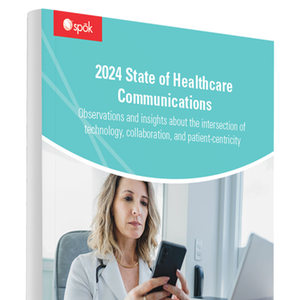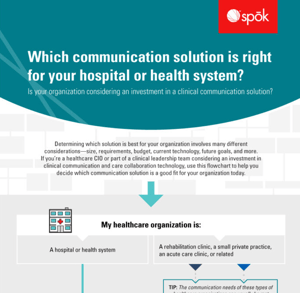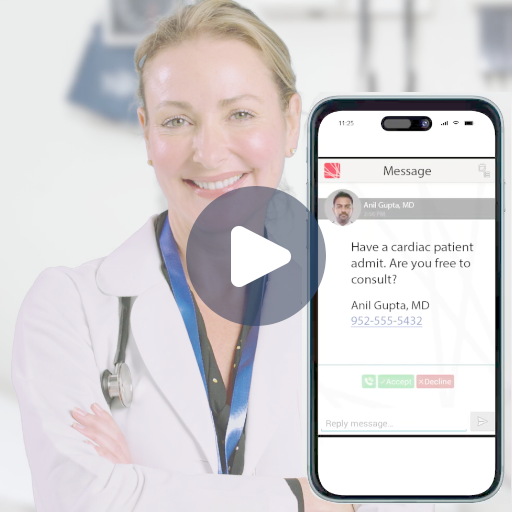Reducing alert fatigue with smarter notification systems: The essential guide for hospitals

Insights into the ongoing issue of alert fatigue
It’s no secret to nurses and hospital administrators that alert fatigue, also known as “alarm fatigue,” is a persistent problem in healthcare spaces. Audible alarms from infusion pumps, cardiac monitors, ventilators, and other machines are constantly competing for clinicians’ attention during their shifts. Too many beeps and signals from these mass notification systems often cause sensory overload, ultimately contributing to clinician burnout.
The Joint Commission estimates that 80 to 99% of alarms sent by medical alert systems do not actually require clinical intervention. At the same time, alert fatigue can be deadly if care teams are desensitized and assume that alarms are false or misdirected—potentially leading to adverse events. In a 2022 study with 348 nurses from twelve departments, specialties, and intensive care units (ICUs), the results below reveal the severity of alarm fatigue and its harmful effects.

|

|

|
|
68% |
65% |
65% 27.7%: were neutral |
Three ways alert fatigue produces harm
Diminished patient safety
Monitoring devices and clinical alert systems are critical to notifying caregivers when a patient’s condition changes in real time. A 2023 study with 213 hospitals found that 83% of participants reported feeling overwhelmed by alarms, and 76% had delayed their response because they could not step away from another patient or task. 55% described experiencing situations where a patient needed urgent attention, but nobody responded to an alarm.
These responses point to the effects of alert fatigue on patient safety. These signals may be perceived as distracting or difficult to decipher—leading them to be turned down, turned off, or adjusted outside of safe limits.
The Joint Commission has identified this multifaceted issue and created NPSG.06.01.01, which reads: Improve the safety of clinical alarm systems.
Increased burnout and turnover
In our 2024 State of Healthcare Communications report, nearly one-third of participants described feeling “a great deal” or “considerably” stressed, which contributes to clinician burnout. Recent research suggests that the complex monitoring devices in today’s hospital units only exacerbate this professional problem.
A study affiliated with the University of Pennsylvania and Yale University revealed that frequently or occasionally experiencing alarm fatigue creates a 2.47 times greater chance of clinician burnout than those who rarely or never experience it; the authors also noted increased clinician burnout if healthcare workers frequently or occasionally encounter situations where nobody has responded to urgent alerts.
Dissatisfied patient experiences
In many hospitals, an overabundance of audible alarms from mass notification systems has contributed to another issue: a too-noisy environment for patients that inhibits their healing, recovery, and satisfaction. For example, constant alerts may contribute to ICU delirium in critically ill patients.
The Hospital Consumer Assessment of Healthcare Providers and Systems (HCAHPS) survey asks patients about these experiences, reporting if they answer that their room is “always” quiet at night. This dissatisfaction caused by medical alert systems is reflected by many hospitals exceeding the proposed noise limits set by the World Health Organization, the International Noise Council, and the Environmental Protection Agency.
Getting started on your alarm management initiative
Alert fatigue is a systemic issue, so your healthcare organization’s response should also be systemic. Ensure your solution addresses all your pain points while encompassing people, processes, and technology. Here are a few stops to get you started:
Do your homework
- Include all stakeholders: A process improvement team for alarm fatigue should have a diversity of disciplines. The entire care team must understand, be trained, and utilize the chosen solution. Remember to include nonclinical roles that impact patient care—like biomedical technologists and health unit coordinators.
- Conduct an alert assessment on each unit: Each unit will have its own set of issues that require unique responses. A comprehensive assessment of your mass notification systems will give a better idea of what’s required to decrease hospital noise on every floor. If you’re having a lot of lead-fail alarms, fixing your alarm defaults won’t matter; you probably have a problem with your electrode practices.
- Clean and monitor equipment: The frequency of alerting systems can often be reduced by simply cleaning and replacing electrodes or by ensuring a monitor is working properly. Regularly changing single-use sensors and establishing routine times to inspect, clean, and maintain equipment is a recommended approach.
- Tailor alerts to patient characteristics: By resetting device parameters for individual patients based on their specific conditions, you can lessen the number of sounding alarms contributing to alert fatigue. This is especially helpful when considering alarms that require immediate attention for one patient might not be as important for the next patient.
Choose the right technology
Go with an enterprise alert management solution: Look for technology that provides a centralized alert management platform across your health system—including biomedical devices, your EHR, and facility devices.
Engaging with your vendor can help you discover new capabilities such as:
- Routing the right message to the right person: By sending alerts from patient monitoring devices directly to the correct clinician’s preferred mobile device (including smartphones, Wi-Fi phones, tablets, or pagers), you can achieve faster response times and more informed decisions that lead to better patient care.
- Lessening noise to increase patient satisfaction: Bypassing the nursing station and sending secure alerts to the correct clinician’s mobile device can reduce the number of calls and overhead announcements from medical notification systems. With minimal noise and quieter environments, patients can have better experiences.
- Triage alerts with software: Intelligent clinical alerting software can incorporate your facility’s preset priority levels and use built-in logic to pass along the highest alarm levels first. Nurses will only receive notifications on their mobile devices that require immediate action. Furthermore, you can build escalation paths to ensure critical alerts receive timely responses.
- Decrease clinically inconsequential alerts: Changing a monitor’s thresholds (when appropriate) can reduce non-actionable alerts within mass notification systems, improving clinician responsiveness overall.
Keep the momentum going
- Ensure proper training: The sophisticated monitoring devices in medical settings today require employees to be educated in sensor management, patient skin preparation, customization of alert parameters, and more. As part of a successful management plan, your healthcare organization should establish procedures to ensure care teams receive continuing education on new and updated devices and protocols within your alerting systems.
- Measure your progress: Keep your healthcare organization on the right path by sharing data about your notification systems, such as alert reduction, general message response rates, and response times for critical test results. These metrics will help refine parameters, optimize escalation paths, and find ways to reduce non-actionable and non-clinically relevant alarms safely. You can also identify any root causes leading to alarm fatigue and clinician burnout—highlighting correctable patient safety issues.
- Support your process improvement team: These people will help push through the rocky spots, particularly during the tough work of maintenance and continuous education about your mass notification systems. Their passion for improving patient care (and, by extension, improving the clinical experience) will keep your initiatives on track.
The bottom line is better patient outcomes
Reducing alert fatigue is a tough job requiring team effort from your staff. This crucial issue involves a complex web of people, communication devices, monitors, and alert sources, so it can be easy for your initiative to lose momentum to enhance your notification systems.
If you haven’t already, start now and prioritize alarm management to improve patient safety and appease clinician burnout. Health systems should have an alarm management plan that works now and later since the number of monitoring devices will only increase in the coming years.
As a pressing challenge for all healthcare organizations, alarm fatigue generates new academic research, technological advances, and best practices shared for others to learn. Use this information strategically and ensure everyone works together for a better healthcare experience.
Looking for more?
Explore our curated selection of resources designed to enhance your understanding and application of high-performing web strategies. Dive into expert insights, case studies, and actionable guides that align with your goals.

eBook: State of Healthcare
A description of the resource being shared. Just a couple of sentences should be just right.
Download >>
Infographic: Which solution is right for you?
A description of the resource being shared. Just a couple of sentences should be just right.
Download >>
Webinar: The ongoing power of paging
A description of the resource being shared. Just a couple of sentences should be just right.
Watch now >>
Case Study: The ongoing power of paging
A description of the resource being shared. Just a couple of sentences should be just right.
Watch now >>
Video: Improving clinical workflow through accurate and efficient communications
Seamless interaction between people and technology is crucial for faster response and enhanced safety in healthcare. See how Spok solutions help Jeremy Rogers' care team coordinate his treatment from the ED to imaging and his patient room.
Watch now >>
Blog: 2024 healthcare communications report
Dive into some of the insights and key findings from our 2024 State of Healthcare Communications report.
Read now >>



